This website uses cookies
This website uses cookies to enable it to function properly and to analyse how the website is used. Please click 'Close' to accept and continue using the website.


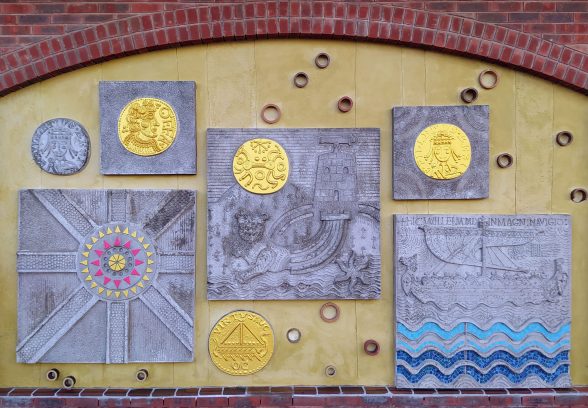
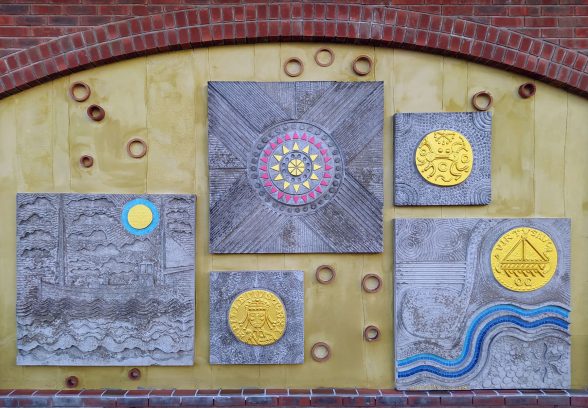
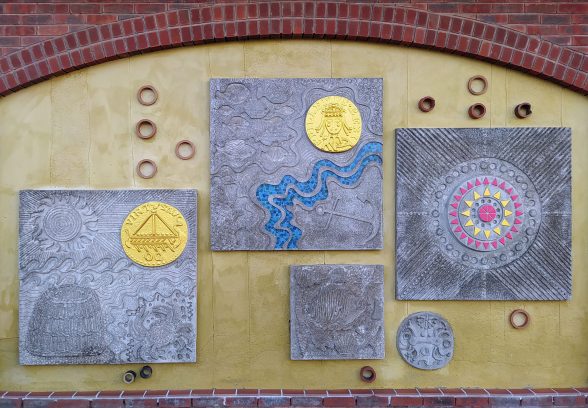
Three post-war concrete murals by artists Henry Collins (1910-1994) and Joyce Millicent Pallot (1912-2004) in Bexhill, East Sussex, have been restored thanks to local volunteers from the Bexhill Heritage conservation group.
The relief murals were commissioned for the then newly constructed J. Sainsbury’s supermarket at Buckhurst place, which opened on June 8 1976, and detail significant moments in the local history, customs and culture of Bexhill – a recurring theme in Collins and Pallot’s place-centric work. These include depictions of gilded coins from the Iron Age, Roman Empire, the era of William the Conqueror – victor at the Battle of Hastings in 1066, and King Offa of Merica, who granted permission for the first church at Bexhill in 722. Also featured are a Norman Longship on the Sussex coast, elements taken from the Bexhill coat of arms (a Martello Tower, Demi-Lion, and the crst fo the Sackville family), and sun motifs that echo the town’s motto ‘Sol et salubritis’ – ‘Sun and health’.
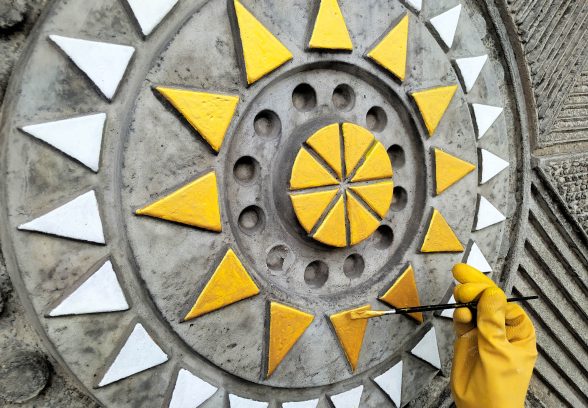
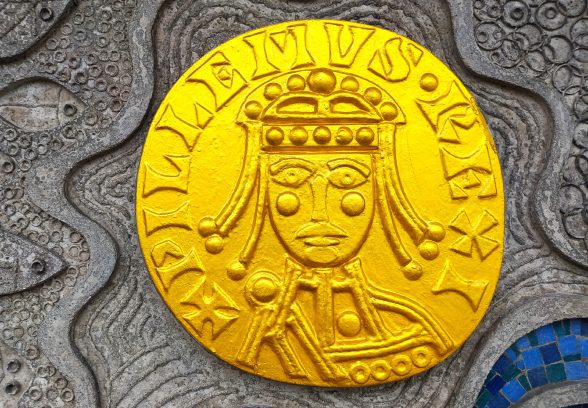
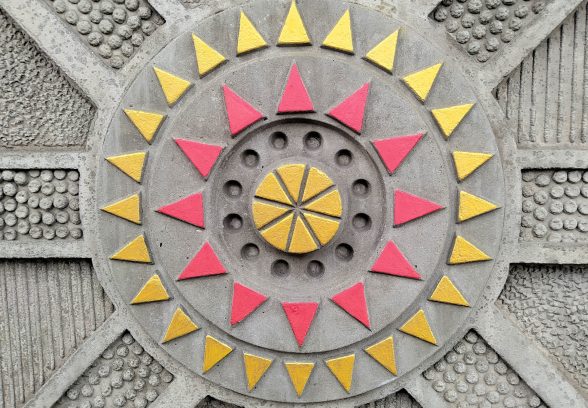
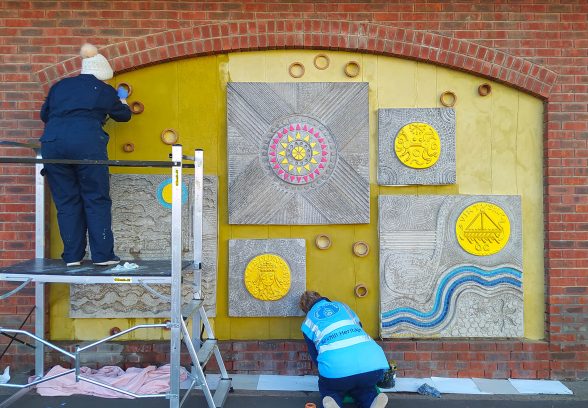
Restoration
Having sought advice from Orbis Conservation based in London (who worked on the other murals from the same artists), it was recommended to avoid using harsh chemical products for an initial clean of the concrete, and to instead use de-ionised water, washing-up liquid and brushes. Volunteers found that the soap began drawing out black oils from the concrete caused by years of exposure to road traffic fumes. To combat this each relief was treated with poultice, an absorbent paste which, when left on for 48 hours draws out much of the staining.
To help stabilise and protect the plaster behind each panel, three coats of a traditional lime-wash paint were applied. Wherever possible, the original gold paint scheme was matched like-for-like: A white undercoat was applied, followed by a base yellow colour, then gold mica powder and exterior varnish are mixed to create a gilded look. A wax coating was applied to the blue mosaic tiles to help protect them, with local tiler Luke Davis helping to replace several missing and broken tiles toward the bottom of the mural.
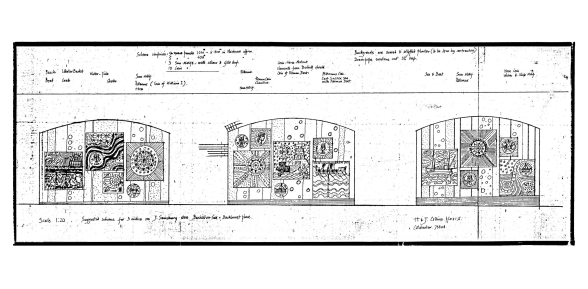
Image credit: Bexhill Heritage
Henry and Joyce Collins
Henry Collins (1910-1994) and Joyce (nee Pallot) (1912-2004) met at the Colchester Art School in 1932 and their first prominent commission was for the Sea and Ships Pavilion for the Festival of Britain, 1951. International commissions included a Wareite (early Formica) piece for the Brussels Exhibition, 1957-8, wallpaper designs for Rasch (German parent company of Sanderson) in 1960 and Formica panels for Expo ’70, Osaka. They founded the Colchester Art Society in 1948 along with Cedric Morris, a teacher of Lucien Freud. Henry Collins went on to teach at the St Martins School of Art, London and Colchester Art School. Joyce Collins continued to be a prominent member of the Colchester Art Society committee alongside alumni including John Nash. Their work has been exhibited widely, including at the Royal Academy.
The Collins’ were first approached by Sainsbury’s in 1969 to provide concrete murals for the new store in their home town of Colchester. A series of commissions for Sainsbury’s ensued along with BHS and other town centre commissions, and corporate work for IBM and Philips among others. Lynn Pearson’s Post War Murals database (2015) estimates that they undertook approximately 28 commissions for public and corporate work from the 1960s into the early 1980s.
The Collins’ work is renowned for the importance they placed on the making process, and particularly the relationship of the finished work to its context. Joyce Collins undertook rigorous historical research into the site in order to develop designs which would have a strong sense of local place, whilst Henry Collins took the lead in drawing. Designs were then translated from paper onto polystyrene moulds using homemade tools – items as mundane as nutmeg graters, a cake mould and a potato chipper were used to produce the most abstract and impressive of their designs.
They did not look to the past purely for iconic inspiration, but sought to learn from the way in which materials such as timber and stone had been manipulated by craftsmen historically, taking cues from church and secular building decoration, paying particular attention to how colour was integrated in other materials. The Collins’ were innovative in their use of colour, often introducing mosaic tiles to the mould that were then transferred during pre-casting. They believed that concrete as a medium did not ‘lend itself naturally to strong, clear colour,’ but that there were ‘definite reasons for using colour with the medium.’ Flat glass mosaics were used ‘to emphasize forms and shapes, at the same time provide a change in texture.’ (Concrete Quarterly, 1975) Casting was then largely carried out nearby at Hutton’s Construction in Birch, Essex.
It is unknown how many of the Collins’ public works survive, though many are thought to have already been lost. In 2014 the Firstsite gallery in Colchester funded the restoration and relocation of three 1976 reliefs by Henry and Joyce Collins, originally from Colchester BHS to 15 Queen Street, Colchester.
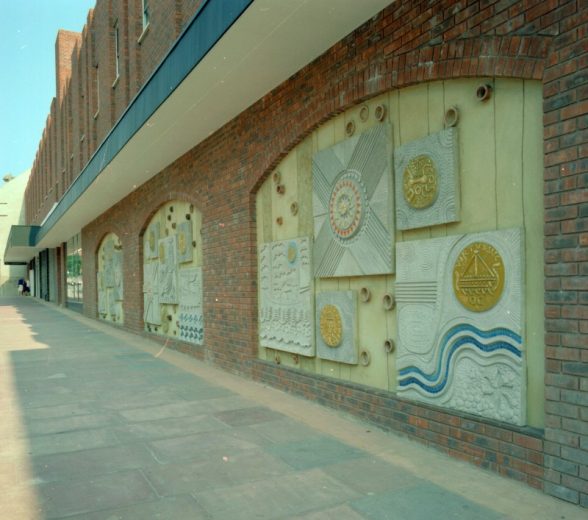
Image: Sainsbury’s Archive
Murals Campaign
Launched in 2009, C20’s Murals Campaign is one of our longest running and most successful initiatives, resultijg in more than 20 examples being nationally listed, and dozens more being saved, restored or rediscovered. In the past two years, listing was secured for 6 significant postwar murals across the country:
There was further good news with confirmation that Alan Boyson’s listed ‘Three Ships’ mural in Hull would be incorporated into the new Albion Square development, and another Joyce Pallot and Henry Collins mural in Colchester was saved from probable loss due to redevelopment.
To alert C20 to any threatened murals in your area, contact caseworker@c20society.org.uk
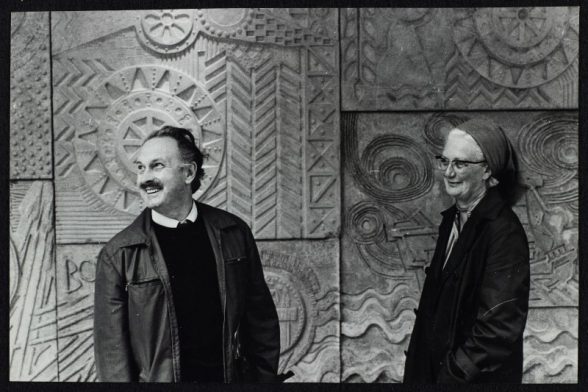
Image: Sainsbury’s Archive

Become a C20 member today and help save our modern design heritage.